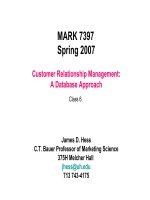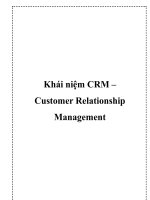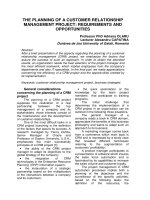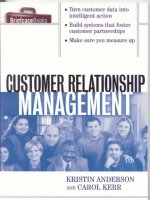Customer Relationship Management 2002 phần 7 pps
Bạn đang xem bản rút gọn của tài liệu. Xem và tải ngay bản đầy đủ của tài liệu tại đây (351.17 KB, 17 trang )
Service-Level Agreements 91
whether a service provider or a customer—may have different
worldviews.
Don’t leave any expectation or requirement unstated. Walk
together through the service process. What will it look like, feel
like, sound like when everything is going well? What types of
issues or service interruptions might you anticipate and how
should those be handled? See Chapter 9, Managing Relationships
Through Conflict, for more on handling possible service problems.
Motorola Uses Analogies
Use analogies and examples to enhance understanding for
your requirements and expectations. For example, a project
group at Motorola needed to create a new agreement with a key cus-
tomer for prioritizing crises.“Every week, or more often even, they
would call with a new crisis—often caused by something that hap-
pened on their end. And they expected us to drop everything and
move mountains.And we did, but we did it so often we were actually
creating more crises on our side. It was a vicious circle. Everything
was becoming a crisis.”
The team leader set up a meeting with his customer. We coached
him to use the language with the customer that he’d used with us. In
the meeting, he explained to his counterpart,“We can move mountains,
just not every mountain, every day.” The image added both humor and
clarity to the discussion.And the customer agreed to prioritize and
expect “only two mountains moved by miracle each month.”
Questions to Ask
To help you anticipate problems, use this checklist. For
each item, ask yourself,“What performance problems
might occur around this issue?” If a performance problem is likely or if
it puts your customer relationships at extreme risk, then it should be
part of your requirements and expectations discussion.
• Personnel
• Facilities
•Power
• Internet/telecommunications connections
• Merger/acquisition
• Disaster
Customer Relationship Management92
When you think you’ve defined the key performance requirements
and expectations, check again with your CRM strategy. Will this
performance truly help you achieve your CRM goals?
When both sides have agreed upon the key performance
requirements and expectations, you’re ready for Step 3: define
performance measures. How will you determine if the agreed-
upon performance level is being met? Measures should be time-
ly and accurate, without placing any undue burden on anyone.
If your SLA concerns an application, you may measure per-
formance with an application monitoring tools. This software
solution can detect and record problems, identify slowdowns, and
run in-depth reports on transactions and response time. If human
performance is at issue, you may need both quantitative and
qualitative measures. Again, compare your performance meas-
ures with your CRM strategy. Are your measures getting at the
performance elements that most promote your CRM approach?
Step 4, define rewards and penalties, goes hand in hand
with Step 3. The performance measure means little until it’s
used to give rewards or to make corrections. Traditional SLAs
focus on remuneration, on what the service provider will give
back if performance falls short. Little, if any, attention is given
to rewards for great performance.
Hanging Up
Operators at a service repair call center were measured
on length of call. Ostensibly, the purpose of this measure
was to create call efficiency, to discourage calls that were unnecessarily
lengthy and chatty. In reality, the operators knew that at three minutes,
the red light on their phones would begin to blink. Some, while in mid-
word, would choose that moment to hang up on the customer.Their
reasoning:“The customer would never believe I hung up on purpose
while I was speaking and management would never believe that I need-
ed more than three minutes to get all the information from the cus-
tomer. But I did and I do. Hanging up just seems like the best option.”
Do your performance measures inadvertently encourage the wrong
performance?
Service-Level Agreements 93
“The reward is, they get to keep the contract,” one manager
told us. “Why should I give them extra if they do what they said
they would do?”
Good point, but what about those times when the service
provider goes above and beyond? You may want to be more
creative in defining rewards. For example, you could ask for a
letter of acknowledgment and praise that you can share with the
service team … or even use in marketing. The key is taking this
opportunity to define ways
to draw customer attention
to superior performance.
Before leaving Step 4,
compare your remunera-
tion and reward agree-
ments with your CRM
strategy. Are you penaliz-
ing any behavior that may
actually promote your
CRM strategy? Are you
rewarding any behavior
that doesn’t serve your
CRM strategy?
Now you’re ready for
implementation, Step 5,
monitor performance.
Here’s where the rubber
meets the road. You’ve
defined expectations and requirements, set up measures, and
decided what you’re going to do—to reward or to correct—based
on the results. Put the process into motion and watch it go.
Keep your CRM strategy in mind as you review your moni-
toring efforts. Are you the monitoring police or the performance
partner? We believe that your monitoring process can and
should actually model the types of relationship you wish to pro-
mote with your customers.
The final step, Step 6, is to review the SLA regularly, at
Don’t Buy the
Problem
“Buying the problem.”
That’s the automotive industry’s
phrase for those times when they just
give the customer money to go away,
rather than fixing their automobile. In
the automotive world, this strategy
makes sense.There are some lemon
cars that just can’t be fixed to the cus-
tomer’s satisfaction. However, in an
SLA, beware of the temptation to just
“pay the price” and settle for per-
formance that doesn’t meet the mark.
Yes, you will be in compliance with
your agreement, but you won’t be
winning the long-term loyalty of your
customer.
Customer Relationship Management94
least annually. The first
year, we recommend that
you review the agreement
even more often, so you
can make any needed
adjustments in expecta-
tions and requirements.
Sometimes it’s only after
an SLA is in place that
you realize that a measure
is sending performance in
the wrong direction or that
your monitoring process is
too cumbersome to pro-
vide timely information.
Equally important in
this step is realizing that
your CRM strategy may change over time, so you’ll need to
adjust your SLA to stay current with it. The following box sum-
marizes the steps we’ve just discussed.
Monitoring Adults
At a managed health care
provider based in
Minneapolis, member services repre-
sentatives are regularly monitored for
quality of calls. A computer system
randomly samples their calls for a
supervisor to review and grade.
However, representatives who’ve
proven themselves by earning consis-
tently high ratings can monitor their
own calls; the supervisor makes just a
few spot checks each year.This
process ensures quality and models an
attitude that “we treat people as val-
ued, capable adults.” What does your
monitoring process model?
Creating an SLA Process Map
Step 1: Review your customer relationship management strategy.
Step 2a: Meet to define requirements and expectations.
Step 2b: Compare to your CRM Strategy. Do the requirements you
set truly help you achieve your CRM goals?
Step 3a: Define performance measures.
Step 3b: Compare your performance measures with your CRM strate-
gy. Do your measures get at the performance elements that most
promote your CRM approach?
Step 4a: Define rewards and penalties.
Step 4b: Compare your remuneration agreement with your CRM
strategy. Are you penalizing any behavior that may promote your
CRM strategy? Are you rewarding any behavior that doesn’t serve
your CRM strategy?
Step 5a: Monitor performance.
Step 5b: Review your monitoring efforts while considering your CRM
Service-Level Agreements 95
Using SLAs to Support Internal Customer
Relationships
Used with your internal customer relationships, SLAs can help
you achieve two of the CRM success factors listed in Chapter 1:
1. Builds strong internal partnerships around the CRM strategy.
2. Employees at all levels and all areas accurately collect
information for the CRM system.
As we stated in Chapter 1, CRM is everyone’s responsibility.
“CRM does not belong just to sales and marketing. It is not the
sole responsibility of the customer service group. Nor is it the
brainchild of the information technology team. … CRM must be
a way of doing business that touches all areas.” Internal SLAs
can help other areas know exactly how they support CRM.
For example, imagine that you’re the manager of the cus-
tomer service group. Your relationship to your organization’s
CRM strategy seems pretty clear. Your group is in contact with
customers every day, using CRM tools to track each transac-
tion, spot new trends as customer expectations change, and
identify opportunities to expand the service relationship.
In addition to your contact with external customers, your
group has internal service relationships with many other areas,
including the warehouse. After reading this chapter, you decide to
create an SLA with this group. As internal partners, you recognize
that the agreement will involve performance-level expectations on
both sides. You’ll bring your concerns and invite your counter-
parts to bring theirs. You’re there to discuss what you expect and
what you need, so that at the end of the day external customers
are well served. CRM, serving customers so well that they want to
continue to do business with you and to find new ways to do
strategy. Are you modeling the type of relationship you wish to pro-
mote?
Step 6a: Review the SLA annually.
Step 6b: Note any changes to your CRM strategy. How must the SLA
change to stay current with your CRM strategy?
Customer Relationship Management96
business with you, is the touchstone for a good agreement.
For example, one of Kristin Anderson’s clients recently
installed a new CRM software tool to track customer problems.
Customer service representatives were instructed to open a
ticket for each customer incident. Some incidents were complex
and needed to be escalated to the engineering group for resolu-
tion. The engineers were good about acting to resolve the issue,
but lousy about recording their actions and closing out the trou-
ble ticket; it just seemed like unnecessary extra work to them.
The manager of the customer service group met with the
engineering team. Without using the term “service-level agree-
ment,” he took them through the process during the meeting.
Once they understood why the information on the trouble ticket
was important and how it was used, they were much more will-
ing to complete the online forms. In return, they asked that
some of the forms be simplified and that the groups agree on
some common shorthand ways of entering information. Recent
monitoring shows that the engineers are following through on
their performance commitments. The internal partnership
between engineering and customer service is stronger than ever.
Your internal service-level agreement may not have the
Get Out of Jail Free
A conference attendee told us about his department man-
ager’s creative effort to develop better working relation-
ships with other internal areas.The original corporate culture placed a
lot of energy on blaming and berating other departments for prob-
lems—which did nothing to get issues resolved for customers. One
day, the manager brought in the “Get out of Jail Free” cards from his
family’s Monopoly
®
game.The next time someone began yelling about a
mistake and blaming his department, he pulled out a card, signed it, and
handed it over.“I’m sorry there is a problem and I want to get it fixed,
ASAP.And to make it up to you, here’s this card.The next time your
area makes a mistake, pull this out and we won’t yell or gripe or com-
plain.We’ll just get to business finding a solution.”
Do your internal service agreements allow you to “get of out jail”
and get to business on behalf of your customers?
Service-Level Agreements 97
financial rewards or remunerations. However, you can be cre-
ative. Maybe you’ll decide to reward superior performance on
either side by hosting a pizza party in appreciation.
Making SLAs Work
Ideally, service-level agreements are a way to ensure that your
performance enhances customer relationships. But SLAs aren’t
a substitute for the ongoing, day-to-day work of uncovering
what your customers expect and need, and searching for new
ways to provide it to them.
Service-level agreements don’t work when:
• Compliance to the “letter of the law” in the agreement
means more than serving the customer.
• Customer needs and expectations change, but the SLA
doesn’t.
• Penalties are ignored or seen as a “cost of doing busi-
ness.”
• Superior performance isn’t recognized and acknowl-
edged in a meaningful way.
Make sure that your formal and informal SLAs don’t fall into
one of these performance traps.
The SLA model—defining accountability, performance lev-
els, and reward and remuneration—is a powerful tool for your
customer relationship management efforts. We encourage you
to take the SLA model and use it with your business-to-business
customers, your consumer customers, and your internal cus-
tomers.
Manager’s Checklist for Chapter 7
❏ A service-level agreement is a promise or guarantee of per-
formance between a service provider and a customer.
❏ SLAs can help you ensure that everyone in your team is on
board and contributing to your customer relationship man-
agement strategy.
Customer Relationship Management98
❏ An effective SLA will spell out accountability, performance
levels, and remuneration.
❏ Creating an SLA is a six-step process: (1) review your cus-
tomer relationship management strategy, (2) meet to define
requirements and expectations, (3) define performance
measures, (4) define rewards and penalties, (5) monitor per-
formance, (6) review. At each step of the way, use your CRM
strategy as a touchstone to ensure that your efforts will serve
to maintain and grow customer relationships.
❏ SLAs with internal customers can help you create strong
internal partnerships around the CRM strategy and can
encourage employees at all levels and all areas to collect
accurate information for the CRM system.
TEAMFLY
Team-Fly
®
99
8
J
ust a few years ago, Kristin Anderson attended a Chapter
Leadership session at the National Speakers Association
conference. As Director of Communications for the Minnesota
Chapter, Kristin was looking for ways to get more information to
chapter members—her NSA-MN “customers”—while spending
less of their money. During a round-table discussion, Kristin
learned that several chapters had done away with expensive
printed newsletters in favor of e-zines or Web-based publications.
“But what about members who don’t have e-mail?” she
asked.
There was a moment of pause, then the discussion leader
replied, “Our chapter doesn’t have any members who don’t
have e-mail.” Kristin just stared.
He went on to explain, “We used to have members who did-
n’t have e-mail. Some of them just didn’t think they needed it—
they had ample business and their customers weren’t complain-
ing. Others didn’t want to make the financial investment. And
some were just plain afraid of the Internet. But a couple of years
E-Commerce:
Customer
Relationships on
the Internet
Copyright © 2002 by The McGraw-Hill Companies, Inc.
Click here for terms of use.
Customer Relationship Management100
ago we made a decision to walk the talk of our mission, to
‘advance the art and value of experts who speak professionally.’
We challenged all our members to move into the electronic age
and offered assistance and advice to those who were unsure.
Today, not every chapter member has—or needs—a Web page
marketing their services, but every member can and does com-
municate with clients, and colleagues via e-mail.”
A leader from another chapter concurred: “Electronic com-
munication is a must. You won’t be taken seriously in this busi-
ness or any business without it.” The message was clear: if you
want to be a business professional, you need to be on the infor-
mation superhighway, the Internet.
A few years ago, we were inclined to argue that not every
business needs to take this road. Today, we are hard-pressed to
find examples of thriving businesses that don’t drive on the infor-
mation superhighway in one way or another. In fact, we are pre-
pared to argue that e-commerce is a nonnegotiable if you want
to maximize your CRM success—no matter what your business.
You have to understand enough about the Internet to under-
stand how e-commerce changes and will continue to change your
customers’ expectations—and how it is changing their relation-
ships with other service providers. As you will read in Chapter 10,
Fighting Complacency, you are in competition with every other
customer service provider your customer experiences.
Who’s Using the Internet? Virtually Everyone
Consider this. Any one of us can download the federal tax
forms we need from the IRS Web site. Is everybody doing
so? No. Many taxpayers don’t have Internet access or they find the
prospect of searching the Web site to be intimidating. So, they contin-
ue to rely on the forms they get in the mail or from local libraries and
post offices. However, a human resources manager recently shared
with us,“I got my forms from someone who used the IRS Web site.”
So, even those people who are just passengers are using the super-
highway. And many of them are easing into taking the wheel.You want
to be out there and ready for them.
E-Commerce: Customer Relationships on the Internet 101
CRM on the Internet
E-commerce really isn’t a
new game. It’s an exten-
sion of the game we’ve
been playing since the
dawn of commerce—the
game of creating, main-
taining, and expanding
customer relationships.
Kristin Anderson’s grandfa-
ther, whom we wrote about in the Preface, never knew about e-
commerce. However, if Carl T. Anderson were running a grain
elevator today, he would find the Internet to be a powerful tool
for communicating with co-op members, watching the market
for pricing trends, scheduling shipments, and completing sales.
To play the game of business in this century, it’s important
to know what e-commerce can do for you and how it’s chang-
ing customer expectations. Working with the touchstone of your
CRM strategy, you’ll be able to use new rules and the new tools
offered by e-commerce to satisfy your customers.
The Internet can enable your customer relationship manage-
ment strategy in three ways.
Level 1: Getting information out to customers. The Internet
can provide an avenue for getting information about your
business and your products and services to your current and
potential customers. At its most basic level, this means letting
them know you are there and how to reach you in the “real
world.” It can be as simple as a Web-based brochure that
describes your products and services and tells customers
where you are located and how to reach you by phone.
Level 2: Getting information back from customers. The next
level of sophistication means you not only provide information
to your customers, but also learn more about them and from
them. The Internet allows you to collect all sorts of useful—and
sometimes not so useful—data about your customers.
Customers on the ’Net
According to Nielsen/Net
Ratings, 167.5 million people
in the United States have home
Internet access.That’s nearly 60% of all
Americans—and the number is rapidly
growing across all demographic groups.
Additionally, nearly half of all Americans
buy on line. Can you really afford not
to be on the ’Net?
Customer Relationship Management102
Sometimes this means customers respond to questions and
provide you useful information. In other cases you may be able
to collect information that’s very useful to your business without
interfering at all with the customer experience.
Level 3: E-commerce sales. At its highest level, you can use
the Internet to deliver products and services to your customers.
You can have mutually rewarding relationships with customers
you never see, meet, or speak with! Your entire relationship can
successfully exist in cyberspace. With the technology available
today, you can sell your products over the Internet, respond to
customer questions, offer additional products and services
based on previous purchases, and evaluate customers’ satisfac-
tion with your offerings—all without ever dealing with them in
person. Leveraging the Internet can free up resources to deliver
higher levels of value to customers in new ways.
Level 1: Getting Information out to Customers
With half of American households wired to the Internet, and the
numbers growing throughout the United States and the world,
you should expect your customers to search the Web for infor-
mation about you and your products and services. From a CRM
standpoint, it’s helpful to think about this level of Internet activi-
ty in two ways, passive and active.
Whether you intend it or not, whether you create it or it
comes from another source, we’re willing to bet dollars to
donuts that you have a presence on the Internet. A search of
the Internet may reveal your passive presence in any number of
ways. Here are just a few:
• Electronic Yellow Pages, such as www.SuperPages.com
• Conversations in an online chat or on an industry- or
association-based bulletin board
• References in articles
While you don’t directly control these sources of informa-
tion—what we consider your passive Internet presence—it pays
to be aware of what your customers will find when they look
E-Commerce: Customer Relationships on the Internet 103
around the superhighway
for you. If you find that
negative information is out
there, what Melinda
Goddard of Roche
Diagnostics calls “word of
mouse,” then you can plan
a strategy to rebut it direct-
ly or to arm your customer
contact employees to address it if customers bring it up.
You can also have an active Internet presence at Level 1 by
putting up a simple, information-based Web page or by placing
articles on sites your customers and potential customers are
likely to visit. The key is to
put your information where
customers and potential
customers will find it and
use it to do business with
you. After all, the core of
CRM is creating, maintain-
ing, and expanding cus-
tomer relationships. You
can’t do that if they can’t
find you.
Level 2: Getting Information Back from Customers
The next level is to use the Internet to get information back from
your customers. There are three general ways to do this.
First, you can simply
have an e-mail address
and make it available to
your customers. For exam-
ple, at the www.briefcase-
books.com site, you can
click on
to ask a general question
Check Your
Signposts
When customers search
for your company through the elec-
tronic Yellow Pages or in a general
Internet search, how quickly does your
information appear? Make it a point to
conduct a monthly Internet search for
your company contact information.
Having a Presence
You don’t have to have your
own Web page to have an
Internet presence. For example, many
small bed and breakfast operators have
Internet listings with their area B&B
association or with their local chamber
of commerce.
Keep Up to Date
Search for your company’s
contact information through
several online yellow or business page
sites. Most of these sites want to hear
from you if your information is missing
or inaccurate. Be proactive in keeping
it up to date.
Customer Relationship Management104
or send a suggestion to John Woods and the team at CWL who
put the series together in partnership with McGraw-Hill. Or you
may click on the
Motivating Employees
book and send a question
or comment directly to co-
author Anne Bruce.
Second, you can also
collect information from
your customers by asking
them to register at your
site. The registration
process allows you to col-
lect some general informa-
tion up front. And, when
customers log in on sub-
sequent visits, Web-based
software can track the way
they use the site so you can learn about what information they
seek out first and most often, what areas of your site they don’t
bother to visit, and how frequently they stop off at your
Superhighway exit. If your customers might balk at signing in
Take Our Challenge
Log onto an Internet search engine. Do a search using your
company or product name. Browse through the results and then
ask yourself these questions:
• How easy is it for a customer to find and contact you via the
Internet?
• Are there any other companies or Web sites with similar names that
might confuse your customers?
• How could you make it easier for customers to find you through an
Internet search?
A quick search of “briefcase books” on www.google.com brought
up the home page for this book series—www.briefcasebooks.com—as
the first entry. However, it also brought up a site for a software com-
pany that has a page recommending fiction books, a possible source of
confusion for readers and potential readers of this series.
Ask the Experts
Kristin Anderson adds to
her active Internet presence
by participating in the “Ask the
Experts” network through
www.TrainingSuperSite.com. Every
time she chooses to answer a question
and it’s posted on the site, Kristin
increases her visibility to clients and
potential clients.Where could you or a
member of your team increase your
Internet presence? And if you serve
internal customers, where could you
increase your presence on your orga-
nization’s intranet?
E-Commerce: Customer Relationships on the Internet 105
just to cruise your site, you
can use CRM software
tools to track them based
on their purchases.
A third way to collect
data from your customers
is by putting surveys or a
question of the day on
your site. It also serves to
actively engage them in
your site. And offering to e-mail them the results or to post the
results on your Web page gives you another opportunity to
communicate with this key
group.
Level 3: E-Commerce Sales
As organizations yearn to
move beyond the tradition-
al world of bricks and mor-
tar, the call goes out: “Let’s
get on the Internet and sell
stuff.” We encourage you
to walk before you run—or
drive—on the e-commerce highway. Even if you launch all three
levels at the same time, consider them in a linear fashion. It’s
important to know what information is already out there about
you—or about your industry or service segment. And before you
start charging credit cards and shipping products, it’s vital that
you have systems and processes in place to receive and answer
customer questions and concerns.
There are two parts to a level-3 Internet presence.
One part is the actual sales of products and services. This is
what comes to mind when we hear the term “e-commerce.”
Large-scale retailers use sophisticated applications to manage
online sales. This requires a large investment and requires high-
volume sales to make it pay off. If you aren’t ready to be in e-
commerce in such a dedicated way, you can still offer your
Use Your Databases
Make sure that customer
purchase tracking tools inte-
grate with other customer databases.
For example, in collecting past-due
payments from a customer, it makes
business sense to offer more leeway to
a long-term customer who always
pays, albeit off schedule.
Check the E-Mail
If you make an e-mail
address available to your
customers, make sure someone checks
it regularly—several times a day is
best. Customers expect quick replies
to e-mail, even if that reply is simply
“We got your message and will have an
answer for you within 48 hours.”
Customer Relationship Management106
products and service by linking to another e-commerce source.
For example, many authors will link their personal sites to their
book publisher’s site or to a large book retailer, such as Amazon
or 800-CEO-READ (formerly Schwartz Business Books).
The other part of your
level-3 presence is provid-
ing real-time customer
service support.
David Sims, writing in
crmguru.com’s Customer
Relationship Management
Primer, notes, “Every per-
son who uses online help
instead of calling you
saves you money.” He
quotes a Web-based customer service application vendor who
explains, “The whole point of online customer service—e-serv-
ice—is to have people taking up your website’s time instead of
taking up your customer service reps’ time.”
You can provide online
customer service through
the following means:
• Search engines—A site-
based search engine
helps your customer
find answers to his or
her questions, locate
information, and con-
nect quickly to the right
department.
• Frequently Asked Questions (FAQs)—A place on your
Web site where you list and respond to the most com-
mon concerns expressed by customers.
• Live help—Your customers can actually speak to a cus-
tomer service representative while they’re online visiting
your site through Voice over Internet Protocol (VOIP)
applications.
The ’Net as Research
Research suggests that up
to 75% of online shoppers
don’t complete their purchase on the
Internet. Instead they use e-commerce
sites to find and research products
before completing their purchase
either by phone or with a visit to a
store location.
Customer Service
and E-Commerce
Forrester Research found
that 37% of all online buyers have
requested customer service online.
90% of online shoppers consider good
customer service to be critical when
choosing a Web merchant. How good
is your online customer service?
E-Commerce: Customer Relationships on the Internet 107
• Online order tracking—With customized applications, you
can allow customers to track the progress of their order,
just as Federal Express allows customers to check pack-
age status over the Internet.
Nazan Fathy, writing for
www.suite101.com, “E-
commerce: All About
Customer Relationship
Management” (April 1,
1999), said, “The epitome
of online service is to
respond to customers in a
consistent and high-quality
manner through their
channel of choice, whether
that is the e-mail, the phone or online chat.”
Choosing the Right Vehicle
Having a presence on the electronic superhighway doesn’t
require that you purchase a brand-new Lexus, but you should
not assume that the cheapest model with no options will do the
job. Choosing the right e-commerce vehicle for you and your
customers is a three-step process.
Step one is to go back to your customer relationship man-
agement strategy. Refresh your memory. Ask yourself three
questions:
1. What am I trying to accomplish with CRM?
2. What kind of experience(s) do I want my customers to have?
3. What information do I need to get to or from my cus-
tomers to enable delivery of an exceptional customer
experience?
We suggest that you keep a written copy of your CRM strategy
close at hand as you work through the next two steps of the
process. Make sure every decision you make along the way is
aligned with your overall CRM strategy.
Voice over Internet
Protocol (VOIP) A fea-
ture that allows visitors to a
Web site to click a “call agent” button.
If your customer has a multimedia PC,
the service representative can have a
conversation with the customer right
over the Internet. Or, the customer
may send a message for the service
rep to call back on a separate line.









